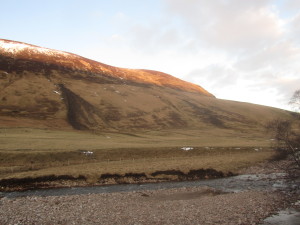I was out ski touring on Saturday on Glas Tulaichean near the Spittal of Glen Shee which was brought into the Cairngorms National Park when its boundaries were extended in 2010. The south side of the river here is part of the Dalmunzie Estate which has an interesting history https://www.dalmunzieestate.com/history/ – its striking just how many people lived here before the estate was cleared – and until the 1970s had its own railway to help transport deer carcasses off the hill in the days before bulldozed tracks.
Dalmunzie is still a stalking and grouse shooting estate and its eagles featured in this year’s BBC Winterwatch. While there were lots of red grouse on the lower part of the hill, higher up there were plentiful mountain hare, the favourite food of eagles. My suspicions is that unlike in the Angus glens Dalmunzie is not involved in slaughtering mountain hares to prevent ticks spreading to red grouse. https://raptorpersecutionscotland.wordpress.com/2016/02/15/more-mountain-hares-slaughtered-in-the-angus-glens/ Fewer hares for eagles of course makes it more likely they will come into conflict with game interests which just encourages further persecution. The Dalmunzie estate has recently been sold https://www.facebook.com/DalmunzieEstate/?fref=nfand it remains to be seen whether it remains a wildlife friendly place. The new owners are not named and there are no controls over who is allowed to buy stalking and grouse shooting estates, not even in our National Parks, so we have no idea whether the estate will be managed in sympathy with the National Park’s objectives. Will the new owners promote conservation, encourage outdoor recreation (as the previous owners did) or even consider some re-population of the lower glen, where so many people used to live?
 After coming off the hill, I noticed recent landslip activity on the hillside on Ben Gulabin on the north side of the river, part of the Invercauld estate. The hillside is so bare there is nothing left to hold the soils in place, the legacy of years of overgrazing. Sheep were dotted all over the lower hillside and one wonders just would it would take for our National Parks to do something? I am reminded of the hillside above the Rest and Be Thankful pass where sheep farming continued long after the landslips which blocked the main road to Argyll became a national story. They were belatedly removed but our National Park Authorities still show extraordinary little interest in what is the greatest ecological issues facing Scotland, overgrazing.
After coming off the hill, I noticed recent landslip activity on the hillside on Ben Gulabin on the north side of the river, part of the Invercauld estate. The hillside is so bare there is nothing left to hold the soils in place, the legacy of years of overgrazing. Sheep were dotted all over the lower hillside and one wonders just would it would take for our National Parks to do something? I am reminded of the hillside above the Rest and Be Thankful pass where sheep farming continued long after the landslips which blocked the main road to Argyll became a national story. They were belatedly removed but our National Park Authorities still show extraordinary little interest in what is the greatest ecological issues facing Scotland, overgrazing.
It is strange: there is a strong belief amongst conservationists in Scotland that ‘high’ grazing is ‘unnatural’. In Scotland we are one of the few countries in Europe, if not the only one, to have kept significant populations of large indigenous herbivores (red deer) throughout the post-glacial period – certainly replaced by sheep in many areas since the 1850s, but when all is said and done there is not a huge difference in grazing impact between sheep and deer. But instead of welcoming this conservation success story, deer are virtually seen as vermin by many, to be shot if they eat trees, in the same way that foxes are shot if they eat capercailzie.Generally we are so used to not seeing animals around us that if we see quite a few, we think there must be something wrong! I still remember being roundly taken to task by the eminent ecologist Bill Heal in the 1970s (later director of ITE) for using the term ‘overgrazing’: “‘Overgrazing’? What do you mean? There is no such thing!” Think how much grazing there must have been in the age of the dinosaurs: these huge animals must have got their food from somewhere! Or when there were large herds of bison in Europe or buffalo on the American prairies.
Generally in natural systems grazing is regulated by food availability (i.e. amount of palatable vegetation), in Scotland particularly in winter. You cannot ‘overgraze’ because animals die when they starve, as do the reindeer on Svalbard. However, if we humans have specific objectives, e.g. more trees, and animals are eating young trees, then it is fair to say an area is ‘overgrazed’ with respect to our objective: the word only has meaning in relation to specific objectives.
As far as grazing causing erosion, well, without erosion there wouldn’t be hills and mountains! Erosion is a perfectly natural process, and heavy grazing can either help prevent it, by producing tightly-bound vegetation, or instigate it through trampling. Likewise trees can either prevent it (particularly in dry climates) or cause it, by blowing over or blocking river courses. The large landslips along the slopes of Loch Lomond in the 1980s were exclusively through forested areas. As for Rest and Be Thankful: when looked at from across the glen, geomorphological analysis would suggest landslips have been occurring here throughout the postglacial period.
‘Overgrazing’ should be a non-issue.